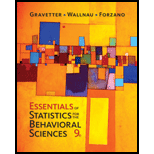
The previous problem demonstrates that removing individual differences can substantially reduce variance and lower the standard error. However, this benefit only occurs if the individual difference are consistent across treatment conditions. In Problem 20, for example, the participants with the highest scores in the neutral-word condition also had the highest scores in the swear-word condition. Similarly, participants with the lowest scores in the first condition also had the lowest scores in the second condition. To construct the following data, we started with the scores in Problem 20 and scrambled the scores in Treatment 2 to eliminate the consistency of the individual differences.
| Participant | Neutral Word | Swearing |
| A | 9 | 5 |
| B | 9 | 2 |
| C | 9 | 5 |
| D | 4 | 10 |
| E | 10 | 8 |
| F | 9 | 4 |
| G | 6 | 7 |
| H | 10 | 5 |
| I | 6 | 8 |
a. If the data were from an independent-measures study using two separate samples, each with n = 9 participants, what value would be obtained for the independent-measures t statistic. Note: The scores in each treatment, the sample means, and the SS values are the same as in Problem 20. Nothing has changed. With α – .05, is there a significant difference between the two treatment conditions?
b. Now assume that the data are from a repeated-measures study using the same sample of n = 9 participants in both treatment conditions. Compute the variance for the sample of difference scores, the estimated standard error for the
Want to see the full answer?
Check out a sample textbook solution
Chapter 11 Solutions
Mindtap Psychology, 2 Terms (12 Months) Printed Access Card For Gravetter/wallnau/forzano’s Essentials Of Statistics For The Behavioral Sciences, 9th
- A well-known company predominantly makes flat pack furniture for students. Variability with the automated machinery means the wood components are cut with a standard deviation in length of 0.45 mm. After they are cut the components are measured. If their length is more than 1.2 mm from the required length, the components are rejected. a) Calculate the percentage of components that get rejected. b) In a manufacturing run of 1000 units, how many are expected to be rejected? c) The company wishes to install more accurate equipment in order to reduce the rejection rate by one-half, using the same ±1.2mm rejection criterion. Calculate the maximum acceptable standard deviation of the new process.arrow_forward5. Let X and Y be independent random variables and let the superscripts denote symmetrization (recall Sect. 3.6). Show that (X + Y) X+ys.arrow_forward8. Suppose that the moments of the random variable X are constant, that is, suppose that EX" =c for all n ≥ 1, for some constant c. Find the distribution of X.arrow_forward
- 9. The concentration function of a random variable X is defined as Qx(h) = sup P(x ≤ X ≤x+h), h>0. Show that, if X and Y are independent random variables, then Qx+y (h) min{Qx(h). Qr (h)).arrow_forward10. Prove that, if (t)=1+0(12) as asf->> O is a characteristic function, then p = 1.arrow_forward9. The concentration function of a random variable X is defined as Qx(h) sup P(x ≤x≤x+h), h>0. (b) Is it true that Qx(ah) =aQx (h)?arrow_forward
- 3. Let X1, X2,..., X, be independent, Exp(1)-distributed random variables, and set V₁₁ = max Xk and W₁ = X₁+x+x+ Isk≤narrow_forward7. Consider the function (t)=(1+|t|)e, ER. (a) Prove that is a characteristic function. (b) Prove that the corresponding distribution is absolutely continuous. (c) Prove, departing from itself, that the distribution has finite mean and variance. (d) Prove, without computation, that the mean equals 0. (e) Compute the density.arrow_forward1. Show, by using characteristic, or moment generating functions, that if fx(x) = ½ex, -∞0 < x < ∞, then XY₁ - Y2, where Y₁ and Y2 are independent, exponentially distributed random variables.arrow_forward
- 1. Show, by using characteristic, or moment generating functions, that if 1 fx(x): x) = ½exarrow_forward1990) 02-02 50% mesob berceus +7 What's the probability of getting more than 1 head on 10 flips of a fair coin?arrow_forward9. The concentration function of a random variable X is defined as Qx(h) sup P(x≤x≤x+h), h>0. = x (a) Show that Qx+b(h) = Qx(h).arrow_forward
 Glencoe Algebra 1, Student Edition, 9780079039897...AlgebraISBN:9780079039897Author:CarterPublisher:McGraw Hill
Glencoe Algebra 1, Student Edition, 9780079039897...AlgebraISBN:9780079039897Author:CarterPublisher:McGraw Hill Big Ideas Math A Bridge To Success Algebra 1: Stu...AlgebraISBN:9781680331141Author:HOUGHTON MIFFLIN HARCOURTPublisher:Houghton Mifflin Harcourt
Big Ideas Math A Bridge To Success Algebra 1: Stu...AlgebraISBN:9781680331141Author:HOUGHTON MIFFLIN HARCOURTPublisher:Houghton Mifflin Harcourt College Algebra (MindTap Course List)AlgebraISBN:9781305652231Author:R. David Gustafson, Jeff HughesPublisher:Cengage Learning
College Algebra (MindTap Course List)AlgebraISBN:9781305652231Author:R. David Gustafson, Jeff HughesPublisher:Cengage Learning


